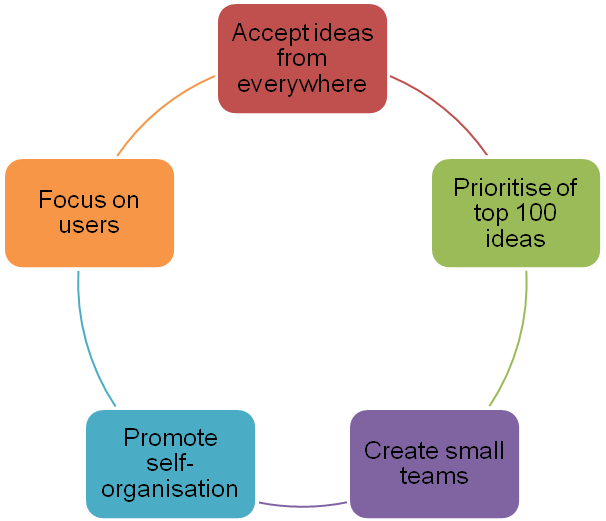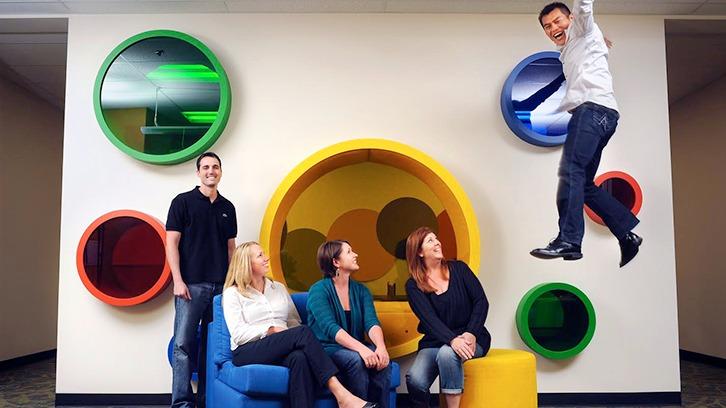Abstract
In this case study, Google is the company for the analysis. The main reason for why this organisation is chosen is its current achievements and success in continuous innovation and impressive management practices (He 2013). People want to know more about the ideas developed by Google and about the ways this company introduces its innovations to the whole world. The peculiar feature of Google is the possibility to use a small group of people, who are able to cooperate and give birth to the ideas that cannot be understood by people around but can be used around the globe.
The success of Google is not always easy to understand, and this case study is an opportunity to investigate the history of the company, its strategic vocabulary including its mission, vision, values, and slogan, and its culture and explain the innovation and risk-taking strategies. Google’s innovation model is a successful combination of the employees’ work, the abilities to analyse the needs of people, and the possibilities to predict the possible effects of their projects on ordinary people. Still, the positions of Google could be improved in case it achieves technological leadership, continues diversifying its products, and develops its HR strategies.
Introduction
Google, Inc. was born in Mountain View, California, in 1998. Its official “parents” are Larry Page and Sergey Brin. They introduced their Internet search engine as an opportunity for people to discover the most appropriate links for their searching process. It was a kind of a play on the word “googol”, the math term for a 1 followed by 100 zeros (Google company: company overview n.d.). It is possible to believe that its name and the way the engine was introduced contained a kind of mystery and some portion of success.
The development of the company was fast and impressive indeed. In 2000, the company introduced the AdWords service program that provided its users with an opportunity to create various ad campaigns online. In 2004, Gmail was offered to the users of Google. Google Maps appeared in 2005 and became one of the frequently used programs of live traffic. Youtube always became a part of the Google team in 2006 (Google company: company overview n.d.).
Google+ was the final project of the company that promoted the development of people, their relations, and interests. Almost every year in the company’s life was characterised by a certain innovation. Innovation becomes the key to the company’s success (Wojcicki 2011). Nowadays, it is hard to count the exact number of services and products developed and offered by Google. It is clear that the founders of the company do not want to stop or change its directions. The only way that is preferred is the development and promotion of new services that could help people to make their lives easier and more interesting.
Strategic Vocabulary
The role of properly set missions, visions, values, and slogan cannot be neglected. People should know the basics according to which Google Company has been working for the last 18 years.
Mission and Vision of the Company
Among the existing varieties of opportunities and human needs, Google creates a mission that is worth to be reached and considered. Google aims at organising the world information and making it universally accessible and useful (About Google n.d.). There is no need to think about the methods that Google tries to use but just believe that such properly established mission could explain the development of the company’s vision statement. Google wants to make sure that all people could find the required portion of information and be sure to share certain amounts of information with the world.
Values and Slogan of the Company
Google is also popular due to short still rather information slogan that depicts the nature of the company and the intentions of its founders. Google employees and leaders truly believe that “don’t be evil” (Google code of conduct 2012) is one of the best ways to explain what each of them wants to achieve in this life. The company always calls for action. In case people see that something is not going right, there is no necessity to wait and keep silence. It is important to find powers and speak up. Regarding such a properly developed Code of Conduct, Google also introduces a list of things the people of the company try to hold to. In the world of management, these things could be defined as the core values of the company.
Focus on the user
It is important for the company to provide users with the best services and stay simple and available at the same time. New tools and applications are developed in the way the user never thinks about additional sources to be used (Google company: what we believe n.d.).
Do one thing really, really well (Google company: what we believe n.d.)
On the basis of search, the company tries to solve the current users’ problems and offer ideas that could be helpful. Employees’ dedication is the main aspect of the company’s actions and decisions. Google employees want to believe that they use the power of search to expand the required portion of information.
Be fast (it is better than to be slow)
Google employees understand that time has its value. Therefore, there is no need to take much time in case it is possible to achieve the goal in a short period of time.
These are not the only values of the company. Still, these rules help to understand what Google people appreciate the most.
Culture of the Company
The company believes that it is really the people, who make Google as it is (Our culture n.d.). Therefore, bright and determined people have to be hired (Hillis, Petit & Jarrett 2013). Much attention is paid to interviews and the creation of proper questions. Poundstone (2013) admits that Google is one of the best companies that use the idea of scaling up due to its unique nature of the business and the abilities of quick growth. Google employees, also called Googlers, should share the same goals and understand the vision of the company. Google is the company with an open culture where employees are free to express their ideas and feelings, talk directly to the founders, and combine their work with the elements of play.
The culture of Google is focused on the ability to combine the importance of creativity, collaboration, and innovation. The employees believe that when they share information openly and try to improve one idea by 10 times but not by 10%, they can achieve the best results and succeed in promoting innovations (Google apps for work: creating a culture of innovation n.d.).
New Product Development
New product development is the process during which a new product or service is brought to market (Beri 2013). Companies cannot ignore the importance of this process because it helps to generalise the ideas, commercialise new products, and maintain personal growth. The peculiar feature of Google Company is that it does not have a clear formula to be followed as the basis of the new product development process. Each time the ideas could be changed, and Googlers have to introduce a new approach for the development of a new product. Still, there are five main tasks that cannot be neglected by the team and have to be considered as an integral part of any new product development process:

Accept Ideas from Everywhere
The first step includes the necessity to find an idea that has to be developed. Each employee is free to use various forums, chats, and other sources to gather as many ideas as possible the development of which could be interesting to people. The example of Google Map Maker shows that the creation of the platform within the frames of which all users could make their own contributions to the already offered maps is a significant achievement for the company (Google apps for work: creating a culture of innovation n.d.).
Prioritise of Top 100 Ideas
As soon as the ideas are gathered, it is necessary to compile them and define their main attributes. Such prioritisation process should help to compare the ideas and choose those which are worth development.
Create Small Teams

The next step is to create the teams and make sure the participants have appropriate working conditions, including free food, places for relaxation, etc. Sometimes, it is enough to have from three to five people and several months to develop a new powerful idea. Still, Google does not want to stop investigating the ways of employees’ cooperation and believe that new approaches to teams’ creation have to be developed (Duhigg 2016).
Promote Self-Organisation

The development process has to be properly organised by the company as well as by each member of a team. A Googler should take responsibility for meeting the deadlines and the requirements set by the company.
Focus on Users
There is no need to think about profits or some personal recognition. The aim of the process is to focus on users and their needs (Brooke 2016). Products and services should be interesting and useful to people.
Company’s Innovation Strategy

The success of the innovation strategy developed by Google depends on the ways of how organisational processes could be developed. This company emphasises the role of leadership, organisational culture, creativity, and innovation. These four factors define the quality of the work and the goals that should be met by all employees.
Effective Leadership
The model developed by Google is also called “google” leadership that is based on a people-centric approach (Steiber 2014). The success of the company could be explained by a properly developed treatment to its employees so that they could have enough time to develop their ideas, contribute the innovation development process, and support the ideas of rapid changes.
Organisational Culture
The company’s culture promotes dynamic capabilities for workers due to constant innovations and changes. Besides, all employees, including its leaders, have to stay open and communicative so that trustful relations should be developed (Steiber 2014).
Creativity
The promotion of a high level of creativity is the way to how Google works. Everything begins with hiring people. It is important to create brainteasers with the help of which creative individuals could be identified (Friedrich 2015). The idea to empower its managers is supported by the company. Finally, diversity is the key to the company’s success. “Unbiasing” programmes are practised in the company to help its employees get rid of their biases and think freely (Friedrich 2015).
Innovation Principles
The company’s innovation process is based on several principles that include the importance to launch and iterate, consider various technical insights, promote the open process, and set the missions that matter. Besides, there is a “20% time” philosophy within the frames of which all employees have the right to spend 20% of their working day on self-development. The results of this philosophy were the creation of such projects as Google News, Gmail, Google Alerts, etc.



Company’s Risk-Taking
There are several risks that could be defined in new product developments. Regardless of its corporate culture’s main idea (that is to promote open collaboration), Google still suffers from a number of uncertainties and the absence of order. Such kind of neglect is the risk that is worth taking because all employees are challenged by the necessity to take actions and demonstrate their individual approaches to the solutions of the problems.
Google culture allows people to take risks (Steiber, 2014). The company is not afraid to deviate from the system and makes its employees suggest changes, develop new products, and share personal opinions anytime. At this moment, the majority of risks taken by the company are introduced in its powerful projects such as Gmail or Google Voice. The impossibility to predict the results of the company is its main advantage because its competitors never know what kind of product could be expected.
Recommendations
Though Google does not have a certain secret formula of success, its leadership, organisational culture, and creativity make the company strong and effective. Its innovation strategies and the abilities to take risks any time its employees want to determine the way of its development. Though it is hard to provide such a giant with some recommendations, it is possible to focus on such improvements as the attempts to achieve technological leadership, continue diversifying its products, and develop its HR strategies that cannot be understood or accepted by other companies. Google is a company that works in its own world.
The results of googlers’ work are unpredictable and impressive. Still, if more attention is paid to HR strategies, its people could define a new level of perfection in the world of online business. Google has already proved itself as a powerful online search engine. A number of applications have been offered. Every day, people discover new needs and suggestions on how to improve their everyday life. One googler should be enough to be in the right place at the right time to become the source of a new innovation in the company. Therefore, the only appropriate recommendation that could be offered to the company is to find more captivating ways to stay as open, devoted, and enthusiastic as Google has been already introduced.
Reference List
About Google n.d. Web.
Beri, GC 2013, Marketing research, Tata McGraw-Hill Education, New Delhi.
Brooke, P 2016, ‘Learn from the best: Google’s nine principles of innovation’, Innovation Coach. Web.
Duhigg, C 2016, ‘What Google learned from its quest to build the perfect team’, The New York Times Magazine. Web.
Friedrich, T 2015, ‘Google spills its work secrets and gives lessons in boosting creativity’, The Conversation. Web.
Google apps for work: creating a culture of innovation n.d. Web.
Google code of conduct. 2012. Web.
Google company: company overview n.d. Web.
Google company: what we believe n.d. Web.
He, L 2013, ‘Google’s secrets of innovation: empowering its employees’, Forbes. Web.
Hillis, K, Petit, M & Jarrett, K 2013, Google and the culture of search, Routledge, New York.
Our culture n.d. Web.
Poundstone, W 2013, Are you smart enough to work at Google?: fiendish puzzles and impossible interview questions from the world’s top companies, Oneworld Publications, New York.
Steiber, A 2014, The Google model: managing continuous innovation in a rapidly changing world, Springer Science & Business Media, New York.
Wojcicki, S 2011, ‘The eight pillars of innovation’, Think with Google. Web.